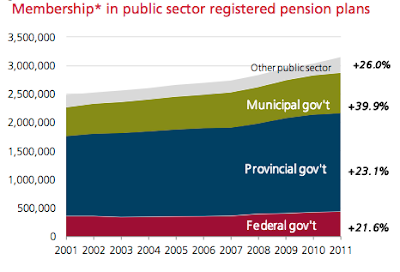A recent report entitled "Public Sector Pensions: a Runaway Train?" by the Canadian Federation of Independent Business (CFIB) examines the looming disaster facing Canada's severely underfunded pension plans. These plans are backed by Canadian taxpayers and will ultimately result in higher taxes. On top of that, Canada's defined benefit public sector pension plans are far ahead of their private sector counterparts, an issue that will create resentment as the two issues combine.
Canada's public sector is a rapidly growing entity. At the beginning of 2011, there were 3.14 million non-retired members of public sector pension plans, an increase of 26.6 percent over the decade as shown on this graph:
By way of comparison, the growth rate of private sector employment was less than half the rate of the public sector, reaching 12.8 percent over the same decade.
The graph shows us that membership in municipal government pension plans grew at 39.9 percent, followed by 23.1 percent for provincial government pension plans and "only" 21.6 percent for those enrolled in federal government pension plans. The overwhelming majority of these future pensioners are enrolled in defined benefit plans, the Cadillac of pensions, where pension income is guaranteed. In sharp contrast, private sector pension plan enrolment remained flat at 2.9 million members over the decade and again, in sharp contrast, only half of those future pensioners are beneficiaries of defined benefit plans.
Public sector employees do contribute a portion of their earnings to cover their future pensions, however, those contributions are only 41 percent of the total set aside. In 2011, of the $31.3 billion set aside for public sector pensions, employees contributed $12.8 billion (highlighted in light blue) and the unfettered generosity of Canadian taxpayers set aside the remaining $18.6 billion (highlighted in dark blue). On top of that, taxpayers funded liabilities averaging $1.3 billion per year (highlighted in black) over the past decade as shown in this graph:
Way back in 2001, an average of $5,754 (in 2011 dollars) was being set aside for the pension of an average public servant; by 2011, this had risen to $9,976 annually, a 73 percent increase.
Despite the setting aside of all of this money, the fact that most public sector pension plans are defined benefit plans means two things; first, taxpayers' liability for funding shortfalls is unlimited and second, the ultimate cost of the pensions is a complete unknown since pension entitlements are tied to salary levels. Estimates by the CFIB suggest that public sector pension plans have a total liability of about $1 trillion against assets of $673 billion, leaving taxpayers holding the bag for more than $300 billion. To put this number into perspective, this is over half of the current federal net debt.
How bad could this get keeping in mind that all levels of government are suffering from the same problem? Right now, the City of Montreal Pension Plan costs account for 13 percent of its entire operating budget. Tiny Prince Edward Island with its 140,000 residents finds its public sector pension plan underfunded by a whopping $436 million or $3,114 for every man, woman and child on the Island. This is roughly 22 percent of the entire provincial debt. To meet a portion of this underfunding, the Provincial Treasurer is setting aside an annual payment of $23.1 million over the next ten years to address only 50 percent of the current shortfall.
Canadian governments at all levels may well find themselves in the extremely unpalatable situation of having to explain to voters why taxes must rise to meet pension shortfalls at the same time as private sector employees find that the value of their defined contribution pension plans are not sufficient to retire on comfortably. With a huge number of baby boomer public servants looking their pensions in the face over the next decade, governments need to make changes to their pension plans now, including changes to defined contribution plans for new employees and the use of "career earnings" rather than "best five year" earnings before the pension train runs over them. Unfortunately, the pension train and the debt train are likely to arrive at the station at the same time!
Click HERE to read more of Glen Asher's columns
You can publish this article on your website as long as you provide a link back to this page.



Why would anyone trustthe words of CFIB on matters liek these.
CFIB became a pariah even amongst other lobby groups with their Wage Watch report claiming to demonstrate that government wmployees earn more than their private sector equivalent – but were only able to ‘prove’ their theory by not counting any of the 70% of sacomment_ID employees that actually earn les than in the private sector.
Since then they have been on the pension bandwagon, falsifying numbers to make their backward logic appear viable. They were taken to task when their spokesperson Tufts was found to be misrepresenting statement by the OTPP CEO, who took Tufts to task.
CFIB has a well known reputation – and it is not a good one.
Here, for example, they are equating deficits in the pension (perhaps they have yet to learn about demographics) with city debt (as if the city was liable to top up these deficits, were they actually a debt). They use numbers for the ‘underfunding’ which are based on the corporate funding model (where more funding has to be made up fron than in a public sector fund) and based on cashing out the plan now but having to pay full benefits as if the fund was still accruing liabilities but not accruing investment returns.
And so on it goes, as with every statement from CFIB and Tufts of FPFA, you can count on the statement being, to be polite, misleading.
Quoting CFIB is to state that factual analysis is irrelevant.